Tamiya 1/24 Morris Mini Cooper 1275S Mk. I
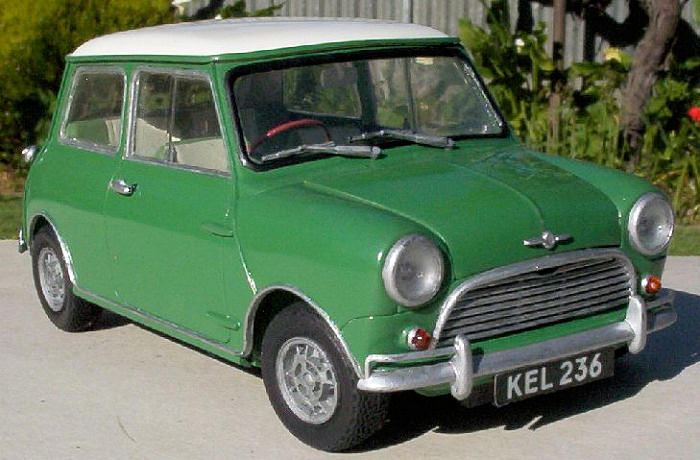
There are certain classic cars that one associates with a country. VW Beetle for
Germany, Citroen 2CV for France, Fiat 500 for Italy, Ford Mustang for USA, and
last but not least, the Morris Mini for Great Britain. Introduced in the London
Motor show in October 1959, with styling by Pininfarina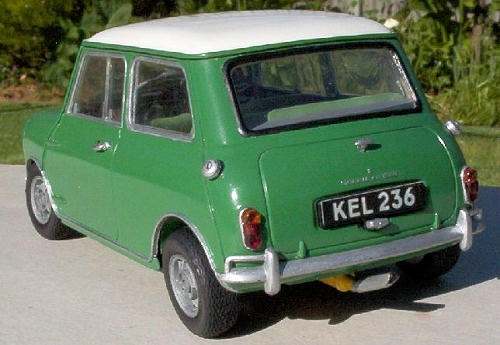 of Italy, it was an
instant sensation. It was powered by an 848 cc four cylinder engine, sideways
mounted and with front wheel drive, taking up only 20% of the 3.05 m length of
the car. This left plenty of room to comfortably fit four adults in a car only
1.4 m wide.
of Italy, it was an
instant sensation. It was powered by an 848 cc four cylinder engine, sideways
mounted and with front wheel drive, taking up only 20% of the 3.05 m length of
the car. This left plenty of room to comfortably fit four adults in a car only
1.4 m wide.
With four wheels at each corner, the Mini also displayed remarkable handling.
With cooperation from Cooper Racing, special racing Minis were developed and
sold. These started with the 997 cc engine in September 1961 (later 998 cc in
January 1964) Mini Cooper with front disk brakes. In March 1963, the 1071 cc
Mini Cooper S was introduced. This Cooper S range was expanded to options of 970
cc and 1275 cc engines in March 1964. The 970 cc and 1071 cc engines were short
lived though, being dropped in April 1965 and August 1964, respectively. UK
production of the Mini Cooper S ceased in June 1971.
During its heydey in the 1960's the Mini went on to win many races, including
the Bathurst 500 in 1966, taking the first four positions outright. I myself
have my own Mini Cooper S, a Mk.I the same as in the kit, but with rolling
windows instead of the earlier sliding windows.
I bought my kit in 1984, not long after I bought my real Mini with one of my
brothers. The kit itself was still new, having been released in 1983. It sat in
the cupboard for 23 y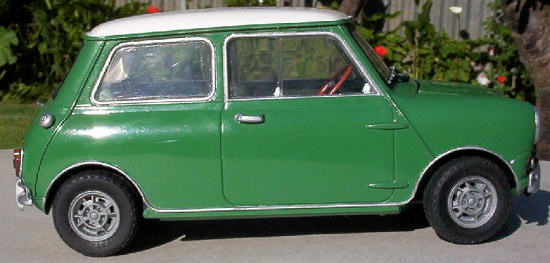 ears, during which I would occasionally take out the box
and admire the perfectly crafted parts. Having rebuilt the engine and gearbox
with a friend, I am intimately familiar with what a Cooper S engine is supposed
to look like. This kit duplicates the engine as faithfully as you can get at a
scale of 1/24.
ears, during which I would occasionally take out the box
and admire the perfectly crafted parts. Having rebuilt the engine and gearbox
with a friend, I am intimately familiar with what a Cooper S engine is supposed
to look like. This kit duplicates the engine as faithfully as you can get at a
scale of 1/24.
It was obvious in the level of detail, that Tamiya had taken a real Cooper S
apart and carefully studied it. However, the air cleaners, rocker cover, wheels,
steering wheel, front shockers and exhaust system had all been modified. This
meant you could not build a standard Cooper S straight from the box, but only a
modified Cooper S. By coincidence, the air cleaners, rocker cover and exhaust
system were the same as in my Mini, but the sliding windows meant that I could
not build the model as a copy of my real Mini.
I decided to make the model straight out of the box, including the same Almond
Green/White scheme used in the box.
Assembly of the kit is pretty straight forward. A problem I had were attaching
the front wheels and body to the chassis. As the front wheels both steer and
rotate, there is not much area in which to glue the wheels on. This meant that
the front wheels would
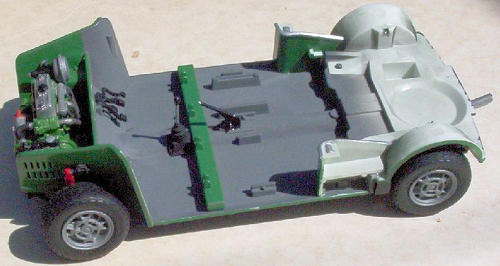 occasionally pop off while being handled. In the end, I
used superglue to attach the front wheels, luckily also to not have any glue
seep in and make the wheels stuck. A side effect of this is that the front
wheels are very loose, as you can see in some of the photos with the front
wheels at an odd angle. The wheels also squeak quite loudly when rotated. I
would recommend you add some scraped pencil lead to held lubricate the wheels.
occasionally pop off while being handled. In the end, I
used superglue to attach the front wheels, luckily also to not have any glue
seep in and make the wheels stuck. A side effect of this is that the front
wheels are very loose, as you can see in some of the photos with the front
wheels at an odd angle. The wheels also squeak quite loudly when rotated. I
would recommend you add some scraped pencil lead to held lubricate the wheels.
Another problem I had was part A2 where the radiator B44 is attached. Part A2 is
attached to the chassis and forms part of
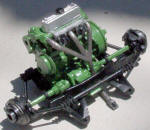 the inner left hand guard. There is
large tab which is used to attach A2, but I removed this so that I could get a
smooth finish. However, while I was polishing this area, I put too much force
and a crack appeared where A2 attached. This meant I had to remask the whole
area and spray again, a tedious process due to how I painted the body. I would
recommend that A2 should be pinned to the chassis. This is where you drill small
holes into the joint and attach a small pin made from short pieces of wire or
pins. This gives a much stronger joint.
the inner left hand guard. There is
large tab which is used to attach A2, but I removed this so that I could get a
smooth finish. However, while I was polishing this area, I put too much force
and a crack appeared where A2 attached. This meant I had to remask the whole
area and spray again, a tedious process due to how I painted the body. I would
recommend that A2 should be pinned to the chassis. This is where you drill small
holes into the joint and attach a small pin made from short pieces of wire or
pins. This gives a much stronger joint.
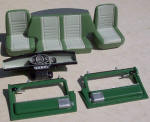 The interior is quit
The interior is quit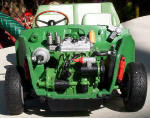 e detailed, with decals being used for the instrument panel.
The only problem I has was in attaching the rear pockets A7 and A8 to the
chassis. These are meant to be butt joined to the raised areas on the chassis. I
had initially glued them in front of the raised areas. The butt join means that
there is visible join line at the bottom of the pockets. However, once the body
is on, this area can not be seen. This is one area where the part design could
have been improved, showing that Tamiya is not perfect.
e detailed, with decals being used for the instrument panel.
The only problem I has was in attaching the rear pockets A7 and A8 to the
chassis. These are meant to be butt joined to the raised areas on the chassis. I
had initially glued them in front of the raised areas. The butt join means that
there is visible join line at the bottom of the pockets. However, once the body
is on, this area can not be seen. This is one area where the part design could
have been improved, showing that Tamiya is not perfect.
To add a bit of detail to the engine, I cut and bent some thin copper wire for
the spark plug leads. These were painted semi-gloss black. The last assembly
problem was attaching the body. I had missed the rear slot in the body that the
chassis goes into. Also, there was not enough room for the spark plug leads, and
as these were not flexible, they broke off. I carefully, removed the chassis and
tried again, this time getting it right. The spark plug leads were then added
again to the engine.
 Throughout the instructions, Tamiya calls out the various Tamiya paints to be
used. As I mainly have Humbrol enamels, I used their equivalent paints. Most of
these are easy to convert, such as Gloss White or Semi-Gloss Black. Of note, I
used H131 Satin Mid Green for the engine, H196 Satin Sky Grey and H120 Matt
Light Green for the seats, and H27 Sea Grey for the carpet. The body colour is
Almond Green. The closest in the Humbrol range I could find is H101 Mid Green.
However, this is a matt colour. I decided to have a go and use this, spraying
gloss clear over the top, to get a gloss finish.
Throughout the instructions, Tamiya calls out the various Tamiya paints to be
used. As I mainly have Humbrol enamels, I used their equivalent paints. Most of
these are easy to convert, such as Gloss White or Semi-Gloss Black. Of note, I
used H131 Satin Mid Green for the engine, H196 Satin Sky Grey and H120 Matt
Light Green for the seats, and H27 Sea Grey for the carpet. The body colour is
Almond Green. The closest in the Humbrol range I could find is H101 Mid Green.
However, this is a matt colour. I decided to have a go and use this, spraying
gloss clear over the top, to get a gloss finish.
For inside the body I used Klear (a floor polish, also known as Future in the
US). For outside the body I used Humbrol Gloss Clearfix. I used two or three
coats to get a reasonable finish. After allowing a week for this to set, I then
polished the body and roof with car polish. This worked really well and I got a
very nice finish. However, I had huge problems with the bonnet (hood in the US).
As I was spraying the last coat of Clearfix on, I noticed the surface behaving
very strangely. Oh no! I was sprayin g with white spirit! I let this dry, sanded
and tried spraying again, but the finish was ruined. The only way to fix it was
to remove all the paint using oven cleaner and start again. A very tedious
process as I have to spray both sides of the bonnet separately.
g with white spirit! I let this dry, sanded
and tried spraying again, but the finish was ruined. The only way to fix it was
to remove all the paint using oven cleaner and start again. A very tedious
process as I have to spray both sides of the bonnet separately.
One good aspect of having a real Mini in the driveway, I did not have far to go
for reference! As the chrome bits look toylike to my eyes, I always dechrome
these parts using bleach and then hand paint by silver. I have a very old tin of
H11 silver, which usually works quite well. I think in future though, I will use
some of the chrome paints that have become available.
This is a great kit of the Mini Cooper S. Apart from the non-standard parts, you
can make an authentic replica of the real car. As is usual with my builds, I
made some errors which made the kit harder to put together then what it should
have been. Hopefully, I can learn from this.
G. Robinson, "Mini Cooper & Cooper 'S' super profile," Haynes Publications,
Newbury Park, 1984.
Steven
S. Pietrobon
November 2008If you would like your product reviewed fairly and quickly, please
contact
me or see other details in the
Note to
Contributors.
Back to the Main Page
Back to the Reviews Index Page


 of Italy, it was an
instant sensation. It was powered by an 848 cc four cylinder engine, sideways
mounted and with front wheel drive, taking up only 20% of the 3.05 m length of
the car. This left plenty of room to comfortably fit four adults in a car only
1.4 m wide.
of Italy, it was an
instant sensation. It was powered by an 848 cc four cylinder engine, sideways
mounted and with front wheel drive, taking up only 20% of the 3.05 m length of
the car. This left plenty of room to comfortably fit four adults in a car only
1.4 m wide. ears, during which I would occasionally take out the box
and admire the perfectly crafted parts. Having rebuilt the engine and gearbox
with a friend, I am intimately familiar with what a Cooper S engine is supposed
to look like. This kit duplicates the engine as faithfully as you can get at a
scale of 1/24.
ears, during which I would occasionally take out the box
and admire the perfectly crafted parts. Having rebuilt the engine and gearbox
with a friend, I am intimately familiar with what a Cooper S engine is supposed
to look like. This kit duplicates the engine as faithfully as you can get at a
scale of 1/24. occasionally pop off while being handled. In the end, I
used superglue to attach the front wheels, luckily also to not have any glue
seep in and make the wheels stuck. A side effect of this is that the front
wheels are very loose, as you can see in some of the photos with the front
wheels at an odd angle. The wheels also squeak quite loudly when rotated. I
would recommend you add some scraped pencil lead to held lubricate the wheels.
occasionally pop off while being handled. In the end, I
used superglue to attach the front wheels, luckily also to not have any glue
seep in and make the wheels stuck. A side effect of this is that the front
wheels are very loose, as you can see in some of the photos with the front
wheels at an odd angle. The wheels also squeak quite loudly when rotated. I
would recommend you add some scraped pencil lead to held lubricate the wheels. the inner left hand guard. There is
large tab which is used to attach A2, but I removed this so that I could get a
smooth finish. However, while I was polishing this area, I put too much force
and a crack appeared where A2 attached. This meant I had to remask the whole
area and spray again, a tedious process due to how I painted the body. I would
recommend that A2 should be pinned to the chassis. This is where you drill small
holes into the joint and attach a small pin made from short pieces of wire or
pins. This gives a much stronger joint.
the inner left hand guard. There is
large tab which is used to attach A2, but I removed this so that I could get a
smooth finish. However, while I was polishing this area, I put too much force
and a crack appeared where A2 attached. This meant I had to remask the whole
area and spray again, a tedious process due to how I painted the body. I would
recommend that A2 should be pinned to the chassis. This is where you drill small
holes into the joint and attach a small pin made from short pieces of wire or
pins. This gives a much stronger joint. The interior is quit
The interior is quit e detailed, with decals being used for the instrument panel.
The only problem I has was in attaching the rear pockets A7 and A8 to the
chassis. These are meant to be butt joined to the raised areas on the chassis. I
had initially glued them in front of the raised areas. The butt join means that
there is visible join line at the bottom of the pockets. However, once the body
is on, this area can not be seen. This is one area where the part design could
have been improved, showing that Tamiya is not perfect.
e detailed, with decals being used for the instrument panel.
The only problem I has was in attaching the rear pockets A7 and A8 to the
chassis. These are meant to be butt joined to the raised areas on the chassis. I
had initially glued them in front of the raised areas. The butt join means that
there is visible join line at the bottom of the pockets. However, once the body
is on, this area can not be seen. This is one area where the part design could
have been improved, showing that Tamiya is not perfect. Throughout the instructions, Tamiya calls out the various Tamiya paints to be
used. As I mainly have Humbrol enamels, I used their equivalent paints. Most of
these are easy to convert, such as Gloss White or Semi-Gloss Black. Of note, I
used H131 Satin Mid Green for the engine, H196 Satin Sky Grey and H120 Matt
Light Green for the seats, and H27 Sea Grey for the carpet. The body colour is
Almond Green. The closest in the Humbrol range I could find is H101 Mid Green.
However, this is a matt colour. I decided to have a go and use this, spraying
gloss clear over the top, to get a gloss finish.
Throughout the instructions, Tamiya calls out the various Tamiya paints to be
used. As I mainly have Humbrol enamels, I used their equivalent paints. Most of
these are easy to convert, such as Gloss White or Semi-Gloss Black. Of note, I
used H131 Satin Mid Green for the engine, H196 Satin Sky Grey and H120 Matt
Light Green for the seats, and H27 Sea Grey for the carpet. The body colour is
Almond Green. The closest in the Humbrol range I could find is H101 Mid Green.
However, this is a matt colour. I decided to have a go and use this, spraying
gloss clear over the top, to get a gloss finish. g with white spirit! I let this dry, sanded
and tried spraying again, but the finish was ruined. The only way to fix it was
to remove all the paint using oven cleaner and start again. A very tedious
process as I have to spray both sides of the bonnet separately.
g with white spirit! I let this dry, sanded
and tried spraying again, but the finish was ruined. The only way to fix it was
to remove all the paint using oven cleaner and start again. A very tedious
process as I have to spray both sides of the bonnet separately.